Page 182 of 240

WHAT YOU SHOULD KNOW ABOUT
AUTOMOTIVE FUELS
Important safety precautions
Do not overfill the fuel tank. The pressure in
an overfilled tank may cause leakage and
lead to fuel spray and fire.
The fuel system may be under pressure. If
the fuel filler cap is venting vapor or if you
hear a hissing sound, wait until it stops before
completely removing the fuel filler cap. Otherwise,
fuel may spray out and injure you or others.
If you do not use the proper fuel filler cap,
excessive pressure or vacuum in the fuel
tank may damage the fuel system or cause the fuel
cap to disengage in a collision, which may result in
possible personal injury.
Automotive fuels can cause serious injury or
death if misused or mishandled.
Gasoline may contain benzene, which is a
cancer-causing agent.
Observe the following guidelines when handling
automotive fuel:
•Extinguish all
smoking materials
and any open flames
before fueling your
vehicle.
•Always turn off the vehicle before fueling.
•Automotive fuels can be harmful or fatal if
swallowed. Fuel such as gasoline is highly toxic
and if swallowed can cause death or permanent
2004 Mustang(mus)
Owners Guide (post-2002-fmt)
USA English(fus)
Maintenance and Specifications
182
Page 184 of 240

Use the following guidelines to avoid static build-up
when filling an ungrounded fuel container:
•Place approved fuel container on the ground.
•DO NOT fill a fuel container while it is in the
vehicle (including the cargo area).
•Keep the fuel pump nozzle in contact with the
fuel container while filling.
•DO NOT use a device that would hold the fuel
pump handle in the fill position.
Fuel Filler Cap
Your fuel tank filler cap has an indexed design with
a 1/8 turn on/off feature.
When fueling your vehicle:
1. Turn the engine off.
2. Carefully turn the filler cap counterclockwise 1/8
of a turn until it stops.
3. Pull to remove the cap from the fuel filler pipe.
4. To install the cap, align the tabs on the cap with
the notches on the filler pipe.
5. Turn the filler cap clockwise 1/8 of a turn until it
stops.
“Check Fuel Cap”illuminates when the ignition is
turned to the ON position to ensure your bulb is
working. When this light turns on, check the fuel
filler cap. Continuing to operate the vehicle with the
Check Fuel Cap light on, can activate the Service
Engine Soon warning. When the fuel filler cap is
properly re-installed, the light(s) will turn off after a
period of normal driving.It may take a long
period of time for the system to detect an
improperly installed fuel filler cap.
If you must replace the fuel filler cap, replace
it with a fuel filler cap that is designed for
your vehicle. The customer warranty may be
void for any damage to the fuel tank or fuel
system if the correct genuine Ford or
Motorcraft fuel filler cap is not used.
2004 Mustang(mus)
Owners Guide (post-2002-fmt)
USA English(fus)
Maintenance and Specifications
184
Page 185 of 240
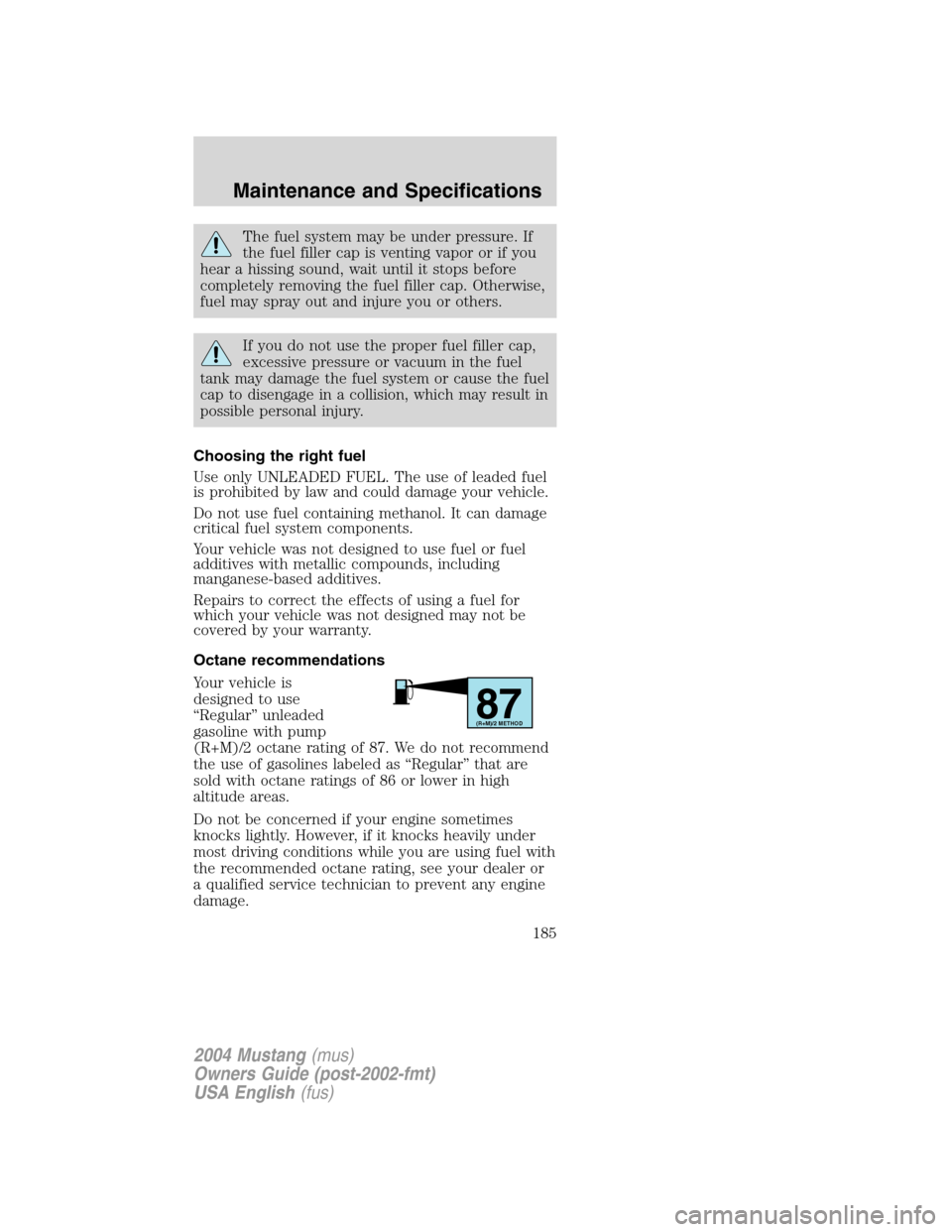
The fuel system may be under pressure. If
the fuel filler cap is venting vapor or if you
hear a hissing sound, wait until it stops before
completely removing the fuel filler cap. Otherwise,
fuel may spray out and injure you or others.
If you do not use the proper fuel filler cap,
excessive pressure or vacuum in the fuel
tank may damage the fuel system or cause the fuel
cap to disengage in a collision, which may result in
possible personal injury.
Choosing the right fuel
Use only UNLEADED FUEL. The use of leaded fuel
is prohibited by law and could damage your vehicle.
Do not use fuel containing methanol. It can damage
critical fuel system components.
Your vehicle was not designed to use fuel or fuel
additives with metallic compounds, including
manganese-based additives.
Repairs to correct the effects of using a fuel for
which your vehicle was not designed may not be
covered by your warranty.
Octane recommendations
Your vehicle is
designed to use
“Regular”unleaded
gasoline with pump
(R+M)/2 octane rating of 87. We do not recommend
the use of gasolines labeled as“Regular”that are
sold with octane ratings of 86 or lower in high
altitude areas.
Do not be concerned if your engine sometimes
knocks lightly. However, if it knocks heavily under
most driving conditions while you are using fuel with
the recommended octane rating, see your dealer or
a qualified service technician to prevent any engine
damage.
87(R+M)/2 METHOD
2004 Mustang(mus)
Owners Guide (post-2002-fmt)
USA English(fus)
Maintenance and Specifications
185
Page 188 of 240
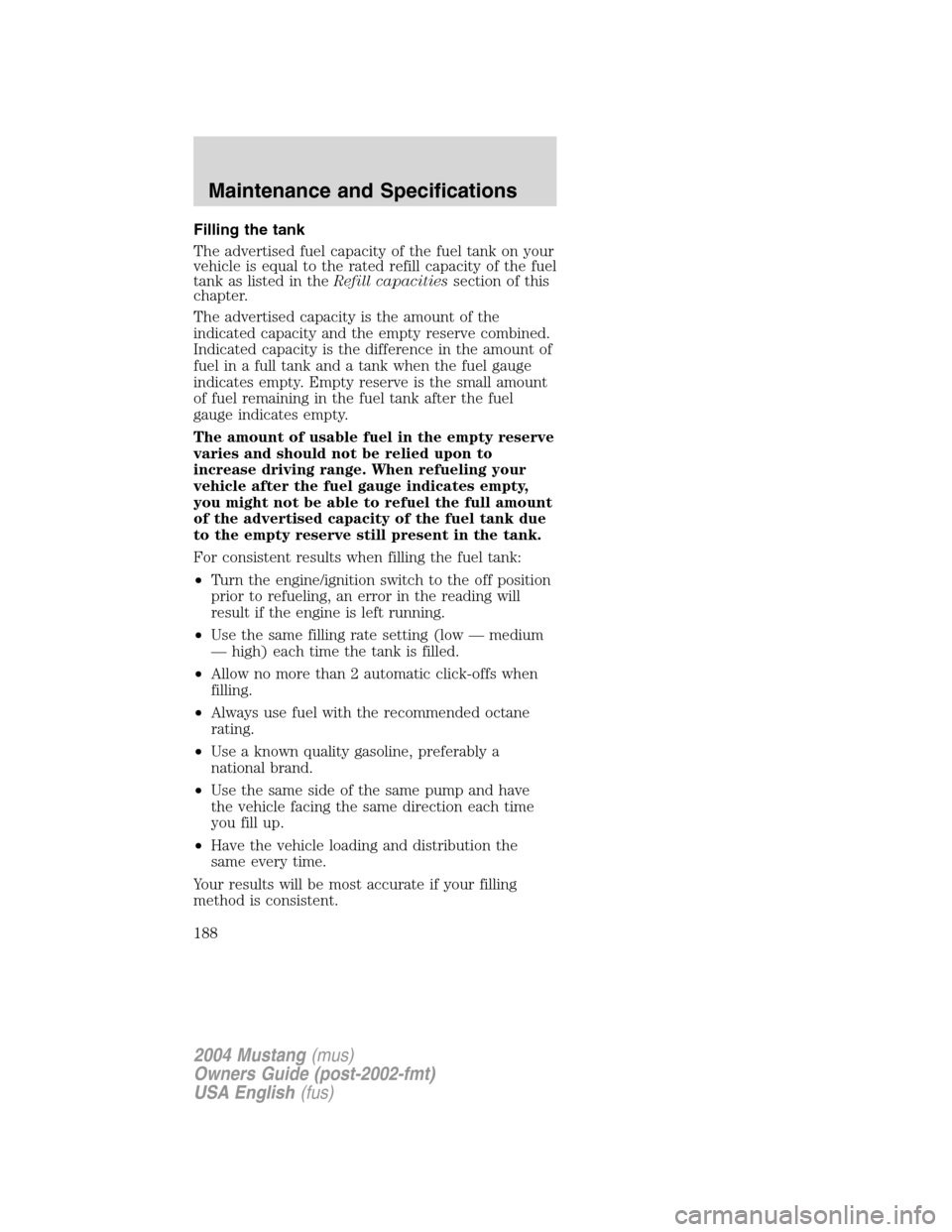
Filling the tank
The advertised fuel capacity of the fuel tank on your
vehicle is equal to the rated refill capacity of the fuel
tank as listed in theRefill capacitiessection of this
chapter.
The advertised capacity is the amount of the
indicated capacity and the empty reserve combined.
Indicated capacity is the difference in the amount of
fuel in a full tank and a tank when the fuel gauge
indicates empty. Empty reserve is the small amount
of fuel remaining in the fuel tank after the fuel
gauge indicates empty.
The amount of usable fuel in the empty reserve
varies and should not be relied upon to
increase driving range. When refueling your
vehicle after the fuel gauge indicates empty,
you might not be able to refuel the full amount
of the advertised capacity of the fuel tank due
to the empty reserve still present in the tank.
For consistent results when filling the fuel tank:
•Turn the engine/ignition switch to the off position
prior to refueling, an error in the reading will
result if the engine is left running.
•Use the same filling rate setting (low—medium
—high) each time the tank is filled.
•Allow no more than 2 automatic click-offs when
filling.
•Always use fuel with the recommended octane
rating.
•Use a known quality gasoline, preferably a
national brand.
•Use the same side of the same pump and have
the vehicle facing the same direction each time
you fill up.
•Have the vehicle loading and distribution the
same every time.
Your results will be most accurate if your filling
method is consistent.
2004 Mustang(mus)
Owners Guide (post-2002-fmt)
USA English(fus)
Maintenance and Specifications
188
Page 193 of 240
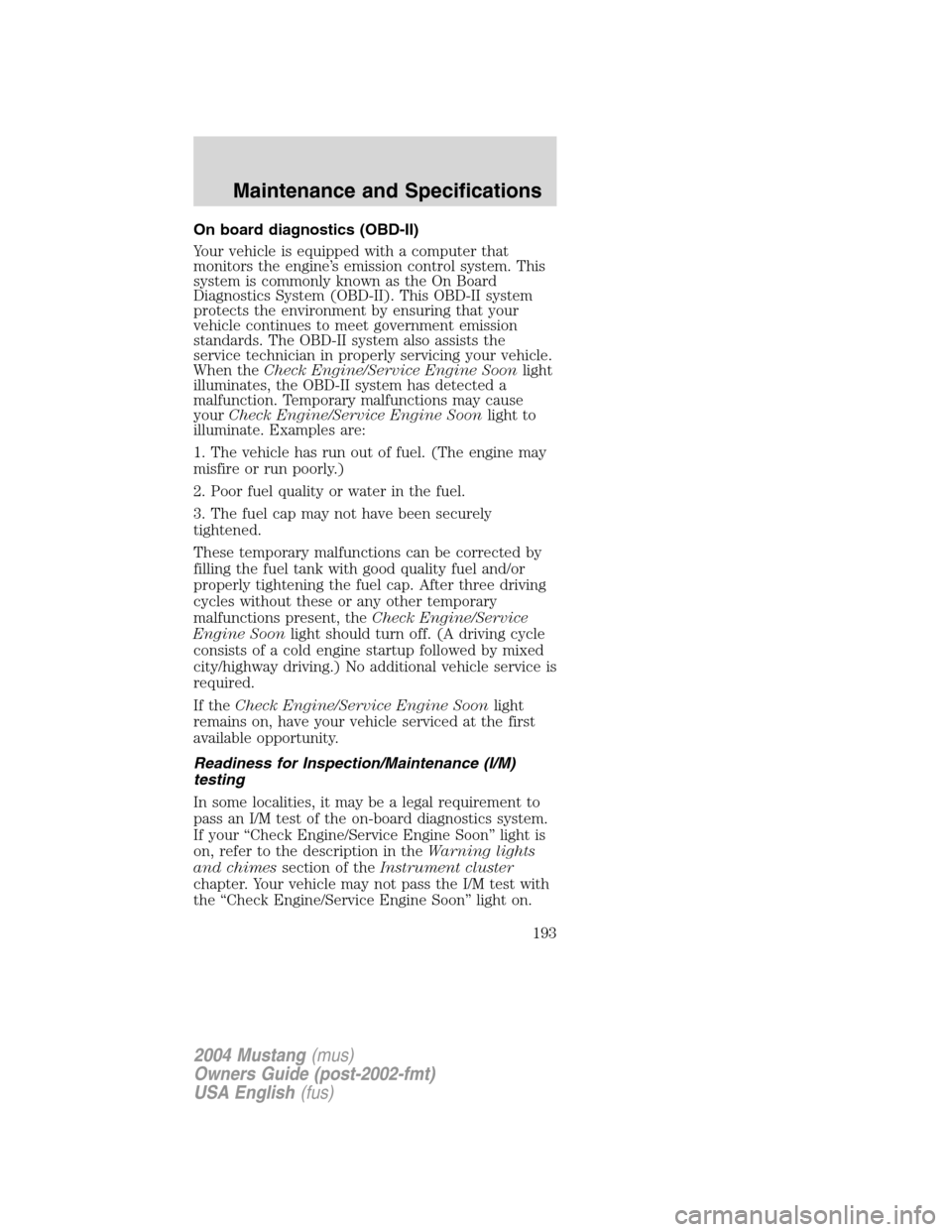
On board diagnostics (OBD-II)
Your vehicle is equipped with a computer that
monitors the engine’s emission control system. This
system is commonly known as the On Board
Diagnostics System (OBD-II). This OBD-II system
protects the environment by ensuring that your
vehicle continues to meet government emission
standards. The OBD-II system also assists the
service technician in properly servicing your vehicle.
When theCheck Engine/Service Engine Soonlight
illuminates, the OBD-II system has detected a
malfunction. Temporary malfunctions may cause
yourCheck Engine/Service Engine Soonlight to
illuminate. Examples are:
1. The vehicle has run out of fuel. (The engine may
misfire or run poorly.)
2. Poor fuel quality or water in the fuel.
3. The fuel cap may not have been securely
tightened.
These temporary malfunctions can be corrected by
filling the fuel tank with good quality fuel and/or
properly tightening the fuel cap. After three driving
cycles without these or any other temporary
malfunctions present, theCheck Engine/Service
Engine Soonlight should turn off. (A driving cycle
consists of a cold engine startup followed by mixed
city/highway driving.) No additional vehicle service is
required.
If theCheck Engine/Service Engine Soonlight
remains on, have your vehicle serviced at the first
available opportunity.
Readiness for Inspection/Maintenance (I/M)
testing
In some localities, it may be a legal requirement to
pass an I/M test of the on-board diagnostics system.
If your“Check Engine/Service Engine Soon”light is
on, refer to the description in theWarning lights
and chimessection of theInstrument cluster
chapter. Your vehicle may not pass the I/M test with
the“Check Engine/Service Engine Soon”light on.
2004 Mustang(mus)
Owners Guide (post-2002-fmt)
USA English(fus)
Maintenance and Specifications
193
Page 215 of 240
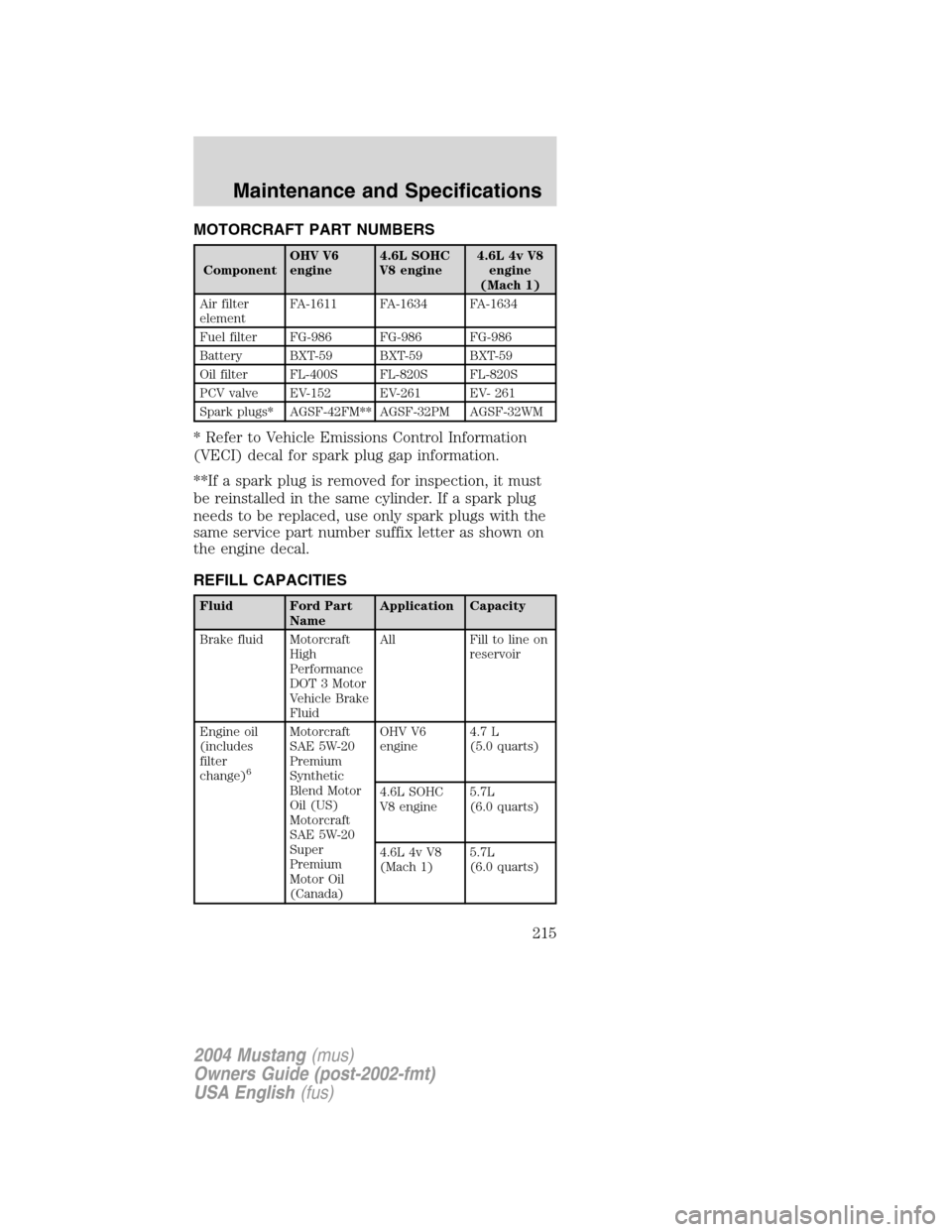
MOTORCRAFT PART NUMBERS
ComponentOHV V6
engine4.6L SOHC
V8 engine4.6L 4v V8
engine
(Mach 1)
Air filter
elementFA-1611 FA-1634 FA-1634
Fuel filter FG-986 FG-986 FG-986
Battery BXT-59 BXT-59 BXT-59
Oil filter FL-400S FL-820S FL-820S
PCV valve EV-152 EV-261 EV- 261
Spark plugs* AGSF-42FM** AGSF-32PM AGSF-32WM
* Refer to Vehicle Emissions Control Information
(VECI) decal for spark plug gap information.
**If a spark plug is removed for inspection, it must
be reinstalled in the same cylinder. If a spark plug
needs to be replaced, use only spark plugs with the
same service part number suffix letter as shown on
the engine decal.
REFILL CAPACITIES
Fluid Ford Part
NameApplication Capacity
Brake fluid Motorcraft
High
Performance
DOT 3 Motor
Vehicle Brake
FluidAll Fill to line on
reservoir
Engine oil
(includes
filter
change)
6
Motorcraft
SAE 5W-20
Premium
Synthetic
Blend Motor
Oil (US)
Motorcraft
SAE 5W-20
Super
Premium
Motor Oil
(Canada)OHV V6
engine4.7 L
(5.0 quarts)
4.6L SOHC
V8 engine5.7L
(6.0 quarts)
4.6L 4v V8
(Mach 1)5.7L
(6.0 quarts)
2004 Mustang(mus)
Owners Guide (post-2002-fmt)
USA English(fus)
Maintenance and Specifications
215
Page 216 of 240
Fluid Ford Part
NameApplication Capacity
Engine
coolant
1Motorcraft
Premium
Gold Engine
Coolant
(yellow-
colored)OHV V6
engine11.2L
(11.8 quarts)
4.6L SOHC
V8 engine13.3L
(14.1 quarts)
4.6L 4v V8
(Mach 1)
with
Automatic
Transmission15.2L
(16.1 quarts)
4.6L 4v V8
(Mach 1)
with Manual
Transmission15.2L
(16.1 quarts)
Power
steering fluidMotorcraft
MERCON�
AT FOHV V6
engineKeep in
FULL HOT
range on
dipstick
4.6L SOHC
V8/4.6L 4v V8
(Mach 1)
engineFill to
between MIN
and MAX
lines on
reservoir
Rear axle
lubricant
2Motorcraft
SAE 80W-90
Premium
Rear Axle
Lubricant7 .5 inch axle 1.5L
(3.25 pints)
Motorcraft
SAE 75W-140
Synthetic
Rear Axle
Lubricant8.8 inch axle 2.0L
(4.25 pints)
Fuel tank N/A All 59.4L
(15.7 gallons)
2004 Mustang(mus)
Owners Guide (post-2002-fmt)
USA English(fus)
Maintenance and Specifications
216
Page 218 of 240
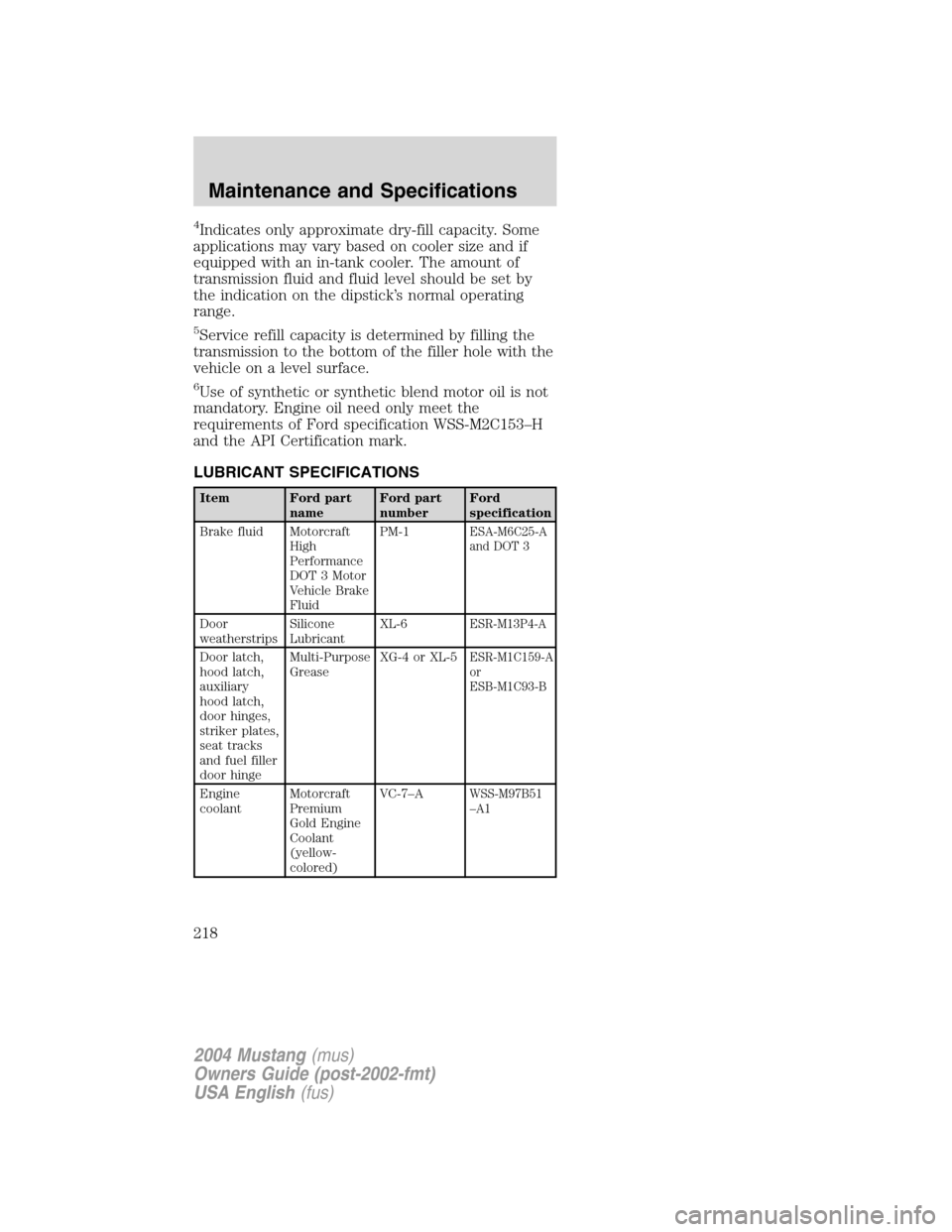
4Indicates only approximate dry-fill capacity. Some
applications may vary based on cooler size and if
equipped with an in-tank cooler. The amount of
transmission fluid and fluid level should be set by
the indication on the dipstick’s normal operating
range.
5Service refill capacity is determined by filling the
transmission to the bottom of the filler hole with the
vehicle on a level surface.
6Use of synthetic or synthetic blend motor oil is not
mandatory. Engine oil need only meet the
requirements of Ford specification WSS-M2C153–H
and the API Certification mark.
LUBRICANT SPECIFICATIONS
Item Ford part
nameFord part
numberFord
specification
Brake fluid Motorcraft
High
Performance
DOT 3 Motor
Vehicle Brake
FluidPM-1
ESA-M6C25-A
and DOT 3
Door
weatherstripsSilicone
LubricantXL-6ESR-M13P4-A
Door latch,
hood latch,
auxiliary
hood latch,
door hinges,
striker plates,
seat tracks
and fuel filler
door hingeMulti-Purpose
GreaseXG-4 or XL-5ESR-M1C159-A
or
ESB-M1C93-B
Engine
coolantMotorcraft
Premium
Gold Engine
Coolant
(yellow-
colored)VC-7–AWSS-M97B51
–A1
2004 Mustang(mus)
Owners Guide (post-2002-fmt)
USA English(fus)
Maintenance and Specifications
218